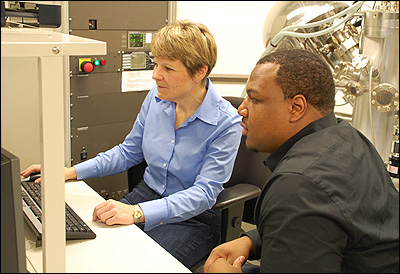Marc Panu is looking forward to a final round in March to determine a first-place award for undergraduate research that will be announced at the 40th annual convention of the National Society of Black Engineers (NSBE) in Nashville.
Panu, a senior in chemical and biomolecular engineering, captured the first-place award in the Undergraduate Students in Technical Research (USTR) Competition among NSBE’s collegiate chapters in Region 3 at its November meeting, moving his paper into national competition March 26-30.

Competitiveness comes naturally to Panu, who played varsity football and became a YouTube sensation after a video caught Vanderbilt’s football coach awarding the three-year walk-on athlete with a senior scholarship in 2012.
“I played football four years at Vanderbilt while majoring in chemical engineering. Although I could have graduated this past May, I decided to spend a fifth year pursuing my research interests, diversifying my academic portfolio and being an active member of the campus community,” said Panu.
“I wasn’t able to do much in the way of extracurricular activities while I was a student athlete, so I could not pass up the opportunity to do research once I was done with football,” said Panu, who is collecting minors in engineering management and in corporate strategy while serving as program chair of Vanderbilt’s NSBE chapter.
Panu is interested in solving practical engineering problems, particularly relating to environmental issues, and specifically to oil and gas industries, and to sustainable energy advances.
Currently working on a manuscript as a first author that will be submitted to a peer-reviewed journal, Panu collaborates with Associate Professor Bridget Rogers, whose research group in chemical engineering creates materials and structures using thin film processing techniques and combustion synthesis.
Panu’s research with Rogers focuses on combustion synthesis. His paper, “Combustion Synthesis and Optical Property Tuning of Cerium-Activated Gadolinium Aluminum Garnet (GAG) Phosphor Powders,” which won NSBE’s Region 3 top award, addresses processes to optimize the color of the white light in solid-state lighting.

“A majority of the energy dissipated in incandescent lighting is in the form of heat rather than light. In order to remedy this problem, scientists and engineers have been seriously investigating solid-state lighting (SSL) for the past decade. SSL provides an energy-efficient alternative to incandescent lighting,” Panu said.
Lighting applications that use light-emitting diodes (LEDs), organic light-emitting diodes (OLEDs), or light-emitting polymers are commonly referred to as SSLs. Unlike incandescent or fluorescent lamps, which create light with filaments and gases encased in a glass bulb, solid-state lighting uses semiconductors that convert electricity into light.
“In order to produce white light, SSL devices combine blue, green and red emissions in the proper proportions. The research I am conducting deals with the green-emitting portion – yttrium aluminum garnet (YAG) and gadolinium aluminum garnet (GAG). By altering the composition of GAG, we can tune the wavelength of the emission in order to optimize the color of the final white light,” he said.
The U.S. Department of Energy reports on its website that SSL technology has the potential to reduce the nation’s lighting energy usage by nearly one half and contribute significantly to climate change solutions. The DOE’s Office of Energy Efficiency and Renewable Energy (EERE) hosts its 11th annual SSL R&D Workshop Jan. 28-30.
“I love to figure things out. I had been content figuring out how to solve problems on paper until I became an undergraduate researcher. It’s a world where equations and numbers aren’t necessarily the end product, but simply vehicles used to actually solve real problems and make real products. This, to me, is the true essence of engineering,” Panu said.
Academics is important to Panu and his family. His older brother is pursuing a master’s degree in counseling and his younger sister is an undergraduate majoring in communications. Panu’s father was born and raised in Zaire (now the Democratic Republic of the Congo) and his mother was born and raised in Trinidad. Panu, a first-generation American, hadn’t lived outside Georgia until he came to Vanderbilt.
“I chose Vanderbilt because of the unique combination of a world-class education and the opportunity to play football in the most competitive conference in college football. Growing up in the South, playing football in the SEC was always a dream of mine,” said the Atlanta native.
“And, I have always had a high propensity for math and science. It’s easy to see how my interest in practical problem solving would lead me to engineering. But, it has also lead me to a serious interest in management,” he said.
Panu sees himself in a career that melds engineering and management – and addresses critical issues in energy and the environment.